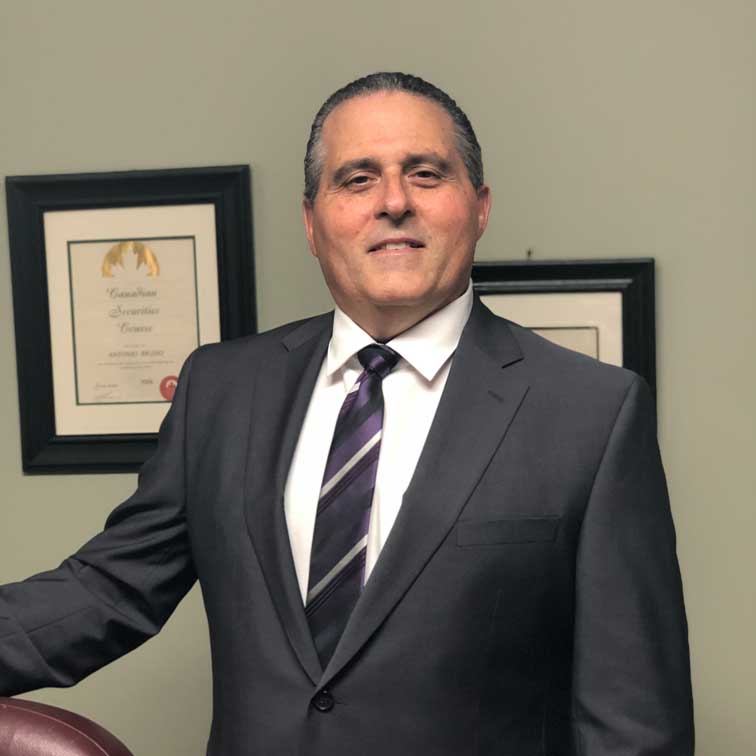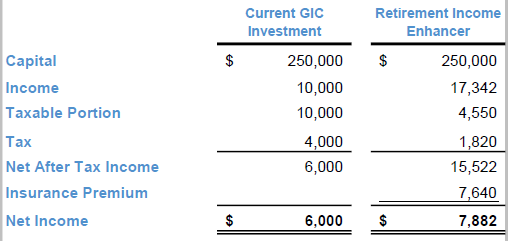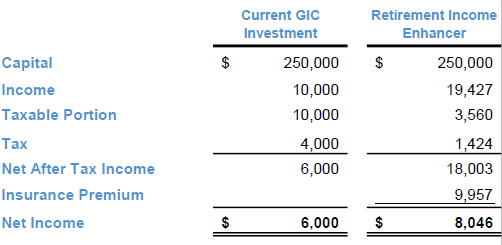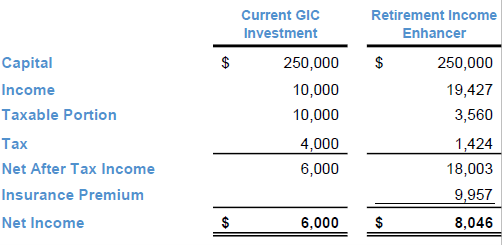My Products

Term Life Insurance
Term insurance covers you for a specific number of years – and is the lowest cost life insurance.
Get a Quote
Permanent Life Insurance
Permanent insurance provides guaranteed coverage for life as well as estate and retirement planning.
Get a Quote
Segregated Funds
Segregated funds combine the growth potential of investment funds with insurance protection.
Get a Quote
Critical Illness Insurance
Critical illness insurance can protect you financially if you suffer a serious illness.
Get a Quote
Disability Insurance
Disability insurance can replace some of your lost income if you miss work due to illness or injury.
Get a Quote

Critical Illness - Laurence's story
Three years ago, Laurence was diagnosed with prostate cancer. This is his story.
Coverage for the important people in your life.
It's important to make informed decisions about protecting your loved ones financially.

Insurance and Investment Calculators

Cash Flow
Access Calculator
Mortgage Loan Payment
Access Calculator
Net Worth
Access Calculator
Retirement
Access Calculator
How Long Will the Money Last
Access Calculator
RRIF Payment
Access Calculator
LIF Payment
Access Calculator
RRSP Tax Savings
Access Calculator
Savings Growth
Access Calculator
Savings to Reach a Goal
Access Calculator
Life Insurance Needs Analysis
Access Calculator
Critical Illness Needs Analysis
Access Calculator
Disability Life Needs Analysis
Access Calculator
Start Education Planning Now
Access CalculatorDollar Cost Averaging
If market volatility has caused you to transfer your
money into GICs or cash, you may want to ask
yourself if you are still on track to meeting your
personal goals. Whether it’s saving for retirement,
a home or a child’s education, keeping money in a
lower-earning investment option may not give you the
growth you need.
My goal is to find the most effective way to put
your money to work and build up your wealth. There
is a tried and tested strategy for investing called
Dollar Cost Averaging (DCA), which smooths out the
costs of investing by regularly buying over time.
One way to do this is investing a lump sum of money
into a temporary safe haven investment holding (ex:
money market) to avoid market volatility and then
systematically switch portions of that into your
target investment(s) over a regular period of time.
This helps you avoid the risk of market timing.
Another way the DCA strategy can be achieved is by
Pre-Authorized Contributions (PACs). PACs allows you
to make withdrawals directly from a saving or
chequing account and then deposit the amount to a
particular investment(s) on a regular basis, such as
monthly or bi-weekly. This will allow your savings
to grow automatically.
Dollar Cost Averaging is right for all
markets
- In a falling market: DCA can let you purchase more securities
- In a rising market: DCA can protect you from paying too much
- In a flat market: DCA ensures you always stay invested
Benefits of Pre-Authorized
Contributions:
- Helps you stick to your plan
- Takes advantage of compound growth
- Eliminates the guesswork of when to invest
- Helps you avoid the rush of yearly RRSP contributions
Double your PAC
Even small increases to a PAC can help you reach
your long-term goals faster. The chart below
illustrates the impact of doubling your PAC on a
monthly contribution overtime of $50 increased to
$100, and $250 increased to $500.
Assumes a 4% annualized rate of return. Used only to
illustrate the effects of compound growth rate and
is not intended to reflect future values of any
particular investment.
This investment strategy helps you minimize
volatility and avoid the risk of market timing. It
is not a one-day initiative but rather a continuous
long-term activity. The earlier you start investing,
the better you will be in the future. I look forward
to discussing these with you in more detail and
seeing how these strategies could assist you in
achieving your goals.
Let’s get started!
Elite Pricing
An important part of investing is making sure you
invest wisely. Even if you invest wisely, you might
still be leaving money on the table if you do not
pay extra attention to your investment fees. You
might remember the old saying, “A penny saved is a
penny earned”. The same idea can be applied to your
investment costs.
You can potentially save thousands of dollars every
year by lowering your investing fees.
One way to access lower investment costs is through
Elite or Preferred Pricing programs. Elite Pricing
is a great way to ensure you keep more of your
money, and it is worthwhile to explore your
options.
How does Elite Pricing
work?
One might think that Elite Pricing or Private Client
programs are available only for wealthy investors.
Fortunately, Elite Pricing is available through most
programs for asset levels starting at $100,000. In
some instances, companies will also have automatic
discounting available to ensure investors receive
fee discounts as soon as they are eligible. So, how
does one know if they are eligible and what are the
criteria? Most investment companies will provide
discounts on fees that are based on the assets
invested. The investment company may also look at
several criteria for discounting such as:
- Fund-level discounts
- Account-level rebates
- Householding
If an Elite Pricing program is geared toward
High-Net-Worth clients, investors may also receive
added features such as: an annual review, and
investment rebalancing services.
As you can see there are many ways that you, as an
investor, can qualify for Elite Pricing. Let’s
connect soon to discuss your plan, and which Elite
Pricing option is best for you.
Contact me today and let’s see how much money you
can save!
RESP Benefits
A Registered Education Savings Plan (RESP) is a special savings account to help Canadian residents save for a child’s post-secondary education.
Benefits include:
- Help you systematically save and plan for a
child’s education
-
Tax-sheltered growth – there’s no taxes payable
on the money earned in a RESP until it’s
withdrawn
-
Government Grants – Government matches 20% of
RESP contributions up to $2,500 each year and to
a lifetime maximum of $7,200
- Additional Grants available for low-income
families
-
Ability to catch up for any prior years you
missed contributing
-
Save on your own schedule - No pre-defined
savings structure within lifetime contribution
limit of $50,000
-
RESP loans can be used to maximize the
Government Grant
-
Most part-time and full-time post-secondary
education qualifies for purposes of a
withdrawal
- With a Family RESP, if one sibling doesn’t pursue post-secondary education, other siblings can use their grant money
Let me help you make the best choices based on
your needs and your situation.
Maximize your RESP
The Registered Education Savings Plan (RESP) is an
investment program where the Government matches 20%
of your contributions. You could even qualify for
additional Grants based on your family income.
There’s also the Canada Learning Bond where the
Government offers up to $2000 for low-income
families.
Start Early
Families with young children can benefit the most
from the RESP. That’s because they will have more
time to qualify for Government Grants, which can be
maximized by contributing to the RESP each year.
Don’t worry! If you miss a year, you can catch up
for one year at a time.
Family Time
If you have more than one child, you can open a
Family RESP. It allows you to keep your savings in a
single account, it simplifies managing the
investments, and if one child doesn’t go to school,
a sibling can use their Government Grant money
without penalty (up to a maximum of $7,200 per
child).
Paying for Education
Most post-secondary programs qualify for educational
withdrawals: academic programs, skilled trade
programs, full-time programs and part-time programs.
Studying abroad also qualifies!
Top Up
If you haven’t yet maximized your RESP contribution
for the year, you can still make a deposit before
the end of December. I can help you calculate the
optimal amount to contribute for this year, or as a
regular monthly deposit.
Let me help you get the most government money that
your child qualifies for.
Beat the Banks
The traditional approach to banking means that each
month millions of Canadians jump through financial
hoops to meet their expenses, pay their bills, cover
borrowing costs and (try to) put something away into
savings and investments.
Most Canadians manage their finances by doing two
things:
- Depositing their income and other short-term assets into chequing and savings accounts.
- Borrowing when they need to, through mortgages, lines of credit, personal loans, and credit cards.
Sounds simple enough. Unfortunately, they usually
receive low or no interest on the money they
deposit, while they pay high interest on the money
they borrow.
Wouldn’t it make more sense if the deposits and
borrowings were combined? Why not have every dollar
you earn paying down your debts until you need to
spend that money?
All-in-one account
One of the most efficient ways of managing debt and
cash flow is to use an all-in-one account, in which
all your savings are directly applied to all your
debt.
In that way, your savings and income automatically
reduce your debt to save you interest.
You can have a combination of your borrowing with a
fixed rate and another portion of your debt in an
open line of credit. The fixed-rate accounts can
help provide payment certainty in a rising interest
rate environment. This approach can reduce interest
costs and lower the risk of overspending in the
account. You can create a tailored debt management
system based on your needs:
- Income
- Lifestyle
- Cash flow surplus (undesignated money left over at the end of the month)
- Interest rate risk tolerance
- Understanding of good debt versus bad debt
Fixed or variable mortgage rates - which one
is right for me?
If you’re looking for a traditional mortgage, you
may not completely understand the difference between
fixed rate and variable rate mortgages. Each has its
own benefits, and your choice will depend on your
situation and your personal preferences. I have
partners that not only can help with this but have
amazing rates too!
Chequing vs Savings
Instead of juggling between a chequing and a savings
account, why not have an option where you can enjoy
the best of both?
Most banks want you to operate with multiple bank
accounts. It's important to know that you're not
maximizing your money by using a separate chequing
and savings account.
There are solutions that can help you benefit from
the higher interest rate of a savings account, along
with the liquidity of a chequing account.
Allow me to refer you to one of my partners that can
assist with any of your banking needs! Together, we
can beat the banks!
Introduction to Segregated Funds
Investing your money is an effective way to put your
money to work and build your wealth. By investing
smart, it helps give you more flexibility to earn
more on your money, build more security for your
retirement, and ultimately give you the chance at
achieving your financial goals and dreams. However,
investing comes with risks. Segregated funds can
help prevent these risks!
Segregated Funds: Investing with peace of
mind
Segregated Funds allow you to invest your money and
help grow your wealth but also gives you peace of
mind knowing that you have protection against
uncertainty.
Unlike other investment options, segregated funds
give you features that aren’t found in the typical
investments (ex. Mutual funds, stocks and GICS):
- Guarantees on your principal – money you invest is guaranteed up to 75% or 100% upon maturity and death
- Reset Options – lets you lock-in market gains that can increase the amount payable upon maturity or death
- Bypass probate – death benefits paid directly to named beneficiary instead of your estate ensures privacy and helps avoid the lengthy and costly process of going through probate
- Potential creditor protection – by designating a
qualified beneficiary, investments may be exempt
from creditors in the event of bankruptcy or
litigation
Who are Segregated Funds
for?
- Pre-retirees looking for wealth accumulation but want to avoid potential losses with maturity and death guarantees
- Individuals looking to preserve their legacy and transfer their estate in a timely, private, and cost-effective manner
- Business owners looking for creditor protection planning
- Anyone who wants the ability to achieve the same type of investment returns as mutual funds but with the security and protection in knowing that their money is protected against any uncertainty
Segregated Funds vs Mutual Funds
|
Investing helps you be more secure and confident about your financial situation. It is not a one-day initiative but rather a continuous long-term activity. The earlier you start investing, the more well-equipped you’ll be in the future. I wish to work together with you and help put the roadmap in place that will help guide you towards your financial goals. Let’s get started!
ESG Investing
More and more, Canadians want their investments to
reflect their personal values and we want our
investments to have an impact for positive change in
the world.
There are many approaches to responsible investing,
including:
Climate change
- Women in leadership
- Community development
- Excluding fossil fuels, weapons, and vices
Companies that perform well on environmental, social
and governance screens may also experience higher
profitability and lower volatility. It’s entirely
possible to do well by doing good.
How can you choose responsible investment funds?
Providers of investment funds use a variety of
approaches to incorporate values-based responsible
investing into their investment processes. As an
independent financial advisor, I can recommend
investment funds that invest in companies who:
- promote environmental sustainability and reducing carbon footprint
- foster social justice and responding to concerns of local communities
- have an independent board of directors and a
diverse management team
If you’d like to review your portfolio and discuss how ethical or values-based funds might fit in your portfolio, please phone me.
Benefits of Segregated Funds
As you know, I’ve helped you manage your risk be it
with life insurance, critical illness, or disability
insurance. I also have expertise in helping you with
your investments and managing risk there too. As an
independent insurance advisor, I’m uniquely
qualified to offer you segregated funds, which are
an investment product with principle guarantees,
lifetime income options, and protection against
premature death.
Segregated Funds: Investing
with peace of mind
Segregated Funds can only be sold by a licensed
insurance advisor. They are similar to mutual
funds but have guarantees and advantages that mutual
funds do not.
Guarantees
A segregated fund policy includes both a maturity
guarantee and a death benefit guarantee. These
guarantees range from 75% to 100% of your principal
investment.
Increasing your guarantees
Segregated funds can include reset options. This
allows you to increase your guarantee values to a
percentage of the market value, thus locking in your
guarantees.
Potential creditor protection
Investments within a segregated fund may be
protected from your creditors, in the case of
bankruptcy or a lawsuit. This feature is
especially important for small business owners and
self-employed professionals
Privacy of your assets
When you pass away some of your investments are
subject to probate and becomes public record.
Segregated funds allow you to bypass probate and
keep those assets private.
Efficient estate planning
By using a segregated fund with a named beneficiary
the proceeds are paid directly to the beneficiary
bypassing probate, thus saving fees and time
allowing the assets to quickly pass to those that
need it the most.
Lifetime income options
Some segregated funds feature lifetime income
options to guard against market risk in retirement
or when guaranteed income is needed.
Who can benefit from owning Segregated
Funds?
- Long-term savers looking to mitigate risk
- Business owners and self-employed professionals
- Retirees
- People planning for their estate
- Those looking for guaranteed income
Let me help you make the best choices based on your needs and your situation.
TFSA
A Tax-Free Savings Account (TFSA) is a personal
savings account that can be used to save for any
goal. After-tax money can go into a TFSA, but
your investments grow tax-free and you won’t pay
any tax on withdrawal.
Who should invest in a TFSA?
- Canadians who have reached the age of majority
- Great for short term, medium-term, and long-term savings
- Best suited for low to medium-income
earners or as a complement to an RRSP
Benefits include:
Earn investment income,
tax-free - Interest, capital
gains, dividends you earn in the account are not
subject to tax
Flexibility to withdraw from
TFSA - Withdrawals are
tax-free and can be at any time, for any purpose
that you choose
Flexible savings plan - Any
unused contribution room in TFSA can be carried
forward. Any withdrawals from a TFSA in one
year, can be recontributed in the next calendar
year
Government benefits stay the same -
Withdrawing from a TFSA and receiving
any amount will not affect the government
benefits you get (ex. Child tax benefit, GIS,
etc.). Current contribution limit per year is
$7,000 as of 2024 and $95,000 if at least 18
years old in 2009 and never contributed to a
TFSA.
Let me help you make the best choices based on
your needs and your situation.
Registered Retirement Savings Plan
The Registered Retirement Savings Plan (RRSP), is a
personal savings plan that lets you save money over
your lifetime on a tax-sheltered basis, so your
money grows faster.
Who should invest in a RRSP?
- Canadians under 71 years of age who earns employment income and wants to save for retirement by reducing their tax bill
- Great for long-term retirement goals and generating ongoing income in your later years
- Best suited for medium to high income earners
Reasons why you should invest in an
RRSP:
Tax-deductible contributions
- Claim your RSP contributions as a deduction on your tax return
- Can carry forward deduction from contribution to future years when income might be higher
Tax-free growth
- Won’t have to pay any taxes on investment gains as long as it remains in the RSP
- Allows retirement savings to grow faster
Generate retirement income for
stability
- When you’re ready to retire, you can convert your RSP to a RRIF or annuity to receive regular payments
- Income from the RRIF will be taxable but in your
later ages, you will potentially be in a lower
tax bracket and pay less tax
Spousal RSP benefits
- Split income in the household by contributing into spousal RSP
- Retirement income can be split more equally
between you and your spouse, generating a
reduced amount of tax that higher income earner
pays
Government withdrawal benefits
- Make withdrawals without paying any tax if you pay the money back within the specified time periods for:
- Home Buyers Plan – withdraw from your RSP to contribute towards your first home purchase
- Lifelong Learning Plan – withdraw from your RSP
to contribute towards education costs
Let me help you make the best choices based on your needs and your situation.
RRSP Loan
An RSP loan can help make sure you’re taking
advantage of RSP tax-deferred investing.
Maximizing your annual RRSP contribution is one of
the best ways to build a secure
retirement.
It could make sense to borrow from your RSP
if you:
- Are looking for a smarter way to manage contributions and cash flow
- Missed making your full contribution in a previous year
- Have a lot of catching up to do
Advantages of RSP Loans:
- Great way for you to meet your retirement goals
- Allows you to maximize the benefit of saving for your retirement
- Increase the potential tax refund that you receive
- Utilize unused contribution room from past years to accelerate tax-deferred savings
- Maximize investment opportunities with a larger access of cash to invest
- Easy term set up, generally can benefit from lower rates than usual during RSP season
A few RSP Loan features include:
Reduce your taxes - By making a
contribution up to your maximum contribution amount,
it may help to reduce the taxes that you are
required to pay
Repayment schedule - Choose a
repayment schedule that works for you
Interest rate options - Choose
between a fixed or variable interest rate
Deferred payment option - Defer
when the payments start; but interest still accrues
Retirement Income Enhancer - Insured Annuity
You are nearing or in your retirement years and want:
- Guaranteed Supplemental Retirement Income
- 100% Capital Preservation
A guaranteed income certificate (GIC) will work
perfectly. The problem is that GIC revenue is
interest income and is taxed at your marginal tax
rate. Also, in today’s interest rate
environment, you will earn approximately 4.0% before
tax.
An alternative is to take your lump sum of cash used
to invest in a GIC and purchase a life
annuity. This pays you a regular income for
the rest of your life. You then use a portion
of that preferentially taxed annuity income to
purchase a permanent life insurance contract.
This will replace the money used to purchase the
annuity when you pass away. This strategy will
typically produce a pre-tax rate of return between
5%-6% and is guaranteed for life.
Benefits of the Retirement Income
Enhancer
- Higher amount of net spendable income
- Income guaranteed for life
- Preferential tax treatment on the annuity income
- Capital replaced at death and paid directly to your heirs
- Beneficiaries can be changed at any time
- No probate fees on the life insurance death
benefit
Example:
- Male 65 non-smoker regular health
- Non-Registered Funds
- GIC rate= 4.0%
- Marginal Tax rate= 40%

An increase of 31% or $1,882/year
Example:
- Male 70 non-smoker regular health
- Non-Registered Funds
- GIC rate= 4.0%
- Marginal Tax rate= 40%

An Increase of 34% or
$2,046/year
Rates are from July 2023 and are subject to
change.
If you are interested in discussing this strategy
and to see if it works for you, please let me know.
Enhance Your Charitable Giving Using Life Insurance
According to Statistic Canada, over $10,000,000,000 was donated from 5,000,000 Canadians to charity in 2019. All these donations are eligible for a non-refundable tax credit.
By using Life Insurance, you can increase your overall charitable donation benefiting a cause that really means something to you. Donating funds to the Canada Revenue Agency through taxation just doesn’t provide the same legacy.
Enhance Your Charitable Giving Using Life Insurance
Below are two structures that allow you enhance your donation to the charity of your choice and potentially pay less tax.
Personally Owned Life Insurance:
- Purchase a Life Insurance policy where you are the owner/payor of the policy with your chosen charity as the beneficiary.
- Policy growth is tax-free increasing your overall donation.
- When you die the charity receives the death benefit tax-free.
- Your estate receives a tax credit of up to 100% of net income for both the year of death and the year immediately preceding it.
- You have access to the cash value during your life as the owner of the policy.
- Can change the beneficiary at any time.
Charity owned Life Insurance:
- Purchase a Life Insurance policy and make the charity the owner and beneficiary. You pay the premiums.
- Every year you receive a tax credit in the amount of the premium paid.
- Maximum donation credit is 75% of net income per year while living.
- Unused credits can be carried forward up to 5 years.
- Charity has access to cash value and they control the policy.
Case
Study
Personally Owned Life Insurance vs a
Non-Registered Investment (Balanced Fund)
|
Comparison Age: 85 | Total
Investment: $500,000 |
|||
| Non-Registered Investment | Life Insurance | ||
| Total Donation to Charity | One time tax credit on death | Total Donation to Charity | One time tax credit on death |
| $907,224 | $435,130 | $1,027,431 | $492,793 |
| Charitable Donation Increase using Life Insurance:$120,202 | |||
Using Life Insurance, you have enhanced your charitable contribution by 13.25% and increased your tax credit by $57,663 that can be used to reduce estate taxes and increase the amount your beneficiaries receive.
Case Study
Charity Owned Life Insurance VS Charity Held
Investment (2% Growth rate as charities have
disbursement quotas limiting the ability for
compound growth)
|
Comparison Age: 85 | Total
Contribution: $500,000 |
|||
| Charity Held Investment | Life Insurance | ||
| Total Donation to Charity | Total Tax Credit | Total Donation to Charity | Total Tax Credit |
| $684,069 | $238,531 | $1,027,431 | $238,531 |
| Charitable Donation Increase using Life Insurance:$343,363 | |||
Using Life Insurance, you have enhanced your
charitable contribution by 33.42%.
The option you choose is dependent on your income
tax situation and where you want to use the
non-refundable tax credit (annually or at the time
of death). With both options, the legacy that you
can provide a charity has been significantly
increased.
If this is something that resonates with you, please
reach out to discuss enhancing your legacy.
Protecting your Retirement Income from an Unforeseen Health Risk
We know most people will make it to retirement without suffering a major illness but if you are one of the unlucky ones, what happens now?
Would you forego 1% of your annual rate of return to eliminate this risk?
Sure, you could use your savings or take out a loan to cover the unexpected costs, however, both options will have a significant impact on your retirements plans. If you need to access your registered funds, they are taxed in the year you use them. Accessing those funds prior to retirement is not part of your plan.
Pass on that risk to an insurance company. They will take care of the rest with an illness recovery benefit. This is a tax-free lump sum payment to cover any number of unforeseen expenses. No need to submit receipts or to justify the costs.
Keep your retirement goals on track
If you are diagnosed and survive a major illness like cancer, heart attack or stroke, you receive an illness recovery benefit payment. This will keep your retirement goals on track.
Below is an example of a typical 40-Year-old, on track, saving for retirement.
After diagnosis, he/she needs to access 100k from their registered account at age 55 to cover additional costs associated with fighting an unfortunate cancer diagnosis. The impact is significant:
Take 1% of your annual rate of return to pay the premium. Your future self and family will be grateful if the worst happens.
Generational Wealth Transfer - Using permanent insurance
You already have excess wealth that you plan to pass on to the next two generations. You want them taken care of financially and have likely earmarked a portion of your investment portfolio for them.
One issue that arises is that all non-registered investment growth is eroded by taxation.
A tax-free permanent insurance policy can make sure your financial legacy extends all the way to your grandchildren.
Have you considered a generational wealth transfer using permanent life insurance? You can take out an insurance policy on your adult children and investment growth in these plans is not subject to annual taxation, increasing your overall wealth. As the owner of the plan, you control money growing inside and can access it during your lifetime if needed.
Your Child
When you purchase the plan and insure your child, they have a valuable asset right away: life insurance protection. You can transfer the policy to them at any time tax free, however most people will transfer the policy at the time of their passing. This is done seamlessly by naming them as a contingent owner on the plan. As the new owner, they now have access to all the money that is growing inside the policy. This money can be used to help buy a home, supplement their retirement, or help fund their child’s education.
Your Grandchild
By naming them as the beneficiary on the policy, you have helped put a foundation in place they can build on. As the named beneficiary on the policy at the time of your adult child’s death (hopefully well into the future) your grandchild will receive the death benefit proceeds tax-free.
This is a great way to help extend your financial legacy. You worked hard to earn it. Make sure your loved ones are the beneficiaries.
Protecting your Retirement Income from an Unforeseen Health Risk
We know most people will make it to retirement without suffering a major illness but if you are one of the unlucky ones, what happens now?
Would you forego 1% of your annual rate of return to eliminate this risk?
Sure, you could use your savings or take out a loan to cover the unexpected costs, however, both options will have a significant impact on your retirements plans. If you need to access your registered funds, they are taxed in the year you use them. Accessing those funds prior to retirement is not part of your plan.
Pass on that risk to an insurance company. They will take care of the rest with an illness recovery benefit. This is a tax-free lump sum payment to cover any number of unforeseen expenses. No need to submit receipts or to justify the costs.
Keep your retirement goals on track
If you are diagnosed and survive a major illness like cancer, heart attack or stroke, you receive an illness recovery benefit payment. This will keep your retirement goals on track.
Below is an example of a typical 40-Year-old, on track, saving for retirement.
After diagnosis, he/she needs to access 100k from their registered account at age 55 to cover additional costs associated with fighting an unfortunate cancer diagnosis. The impact is significant:
Take 1% of your annual rate of return to pay the premium. Your future self and family will be grateful if the worst happens.
Simplifying insurance coverage - Rent, Lease or Own
At times, it can feel like Life Insurance Companies have overcomplicated the products they provide by using fancy names and acronyms.
This has left many Canadians feeling confused. Fundamentally, there are only three plan types to choose from when purchasing life insurance. You can rent, lease or own the insurance. Below is an explanation of the merits of each which will hopefully provide clarity and make decision making easier.
The right life insurance solution for you depends on your immediate needs and long-term goals. Term life insurance and permanent life insurance are two very different kinds of protection that satisfy different needs.
Renting Life Insurance
The first and most important decision is to cover off your debt and lost income if something were to happen in the short to mid-term. This is called term insurance. Think of this like anything you rent (Car, House, Boat, Skis). You pay a lower amount than purchasing the item outright and when you don’t need it anymore or your rental time is up, you give it back. That is it. Term insurance is the exact same. You pay a lower amount for access to a higher amount of coverage because you hope you don’t have to use it. You can lock in term (rental) rates anywhere from 5-50 years depending on your situation.
Highlights:
- Low initial cost
- Pays out only if the insured dies
- Rates usually go up after the term
- Plan expires at a certain age
Leasing Life Insurance
The next option is to look at permanent insurance. This plan is guaranteed to pay out at some point in the future. Think of this as a lifelong lease. When leasing a property, you might lock in a 5-year lease. Here you are locking in a rate today (more expensive than the rental option) for the rest of your life.
Highlights:
- Level premium for lifetime
- Coverage never expires
- You control the policy: company can’t change or terminate it
Owning Life Insurance
The third type of insurance is where you own an equity portion inside the
policy. Think of it like owning a house. When you take out a mortgage on a
property you pay the bank a monthly amount until your mortgage is paid off and
you “own” your house free and clear. With this type of insurance, you pay a
monthly/annual premium (higher than the lease option as part of your deposit is
invested). Each year, the investment component grows tax-sheltered and that is
what you “own”. Think of it as the "equity" in your life insurance, similar to
the equity in your home. You can structure the plan to have a “limited” payment
period (usually 10-20 years) or choose to pay for life. This “Cash Value” is
yours and will continue to grow over time.
Highlights:
- Guaranteed 10, 15 or 20 pay
- Coverage never expires
- Cash values and loan values
- You control the policy: company can’t change or terminate it
As a recap, there are only 3 structures when it comes to life insurance (Rent, Lease, Own). If you would like to discuss this in more detail, please feel free to reach out and we can find a solution that meets your family’s needs.
Which job would you choose? Job A or Job B?
You have been offered a job and get to pick between two different compensation structures. Which one are you choosing?
Job A will pay you $80,000/year while working and $0 if you are unable to work due to an injury or illness.
Job B will pay you $78,500/year while working and $53,000 (tax-free) if you are unable to work due to an injury or illness.
With an Income Replacement Benefit, you create a safety net around you and your family. You own and control the policy and the rates are guaranteed until you turn 45.
This chart illustrates your earning potential during your working years. If you are unable to work due to an illness or injury, you still need a regular monthly income. Put the insurance company’s money to work so your family can maintain the same standard of living.
Your Earning Potential by age 45:
|
Annual Income |
At Age 25 |
At Age 35 |
At Age 45 |
|
$35,000 |
$2,359,089 |
$1,536,595 |
$894,063 |
|
$50,000 |
$3,370,128 |
$2,195,135 |
$1,277,233 |
|
$65,000 |
$4,381,166 |
$2,853,676 |
$1,660,403 |
|
$90,000 |
$6,066,230 |
$3,951,243 |
$2,299,019 |
|
$120,000 |
$8,088,306 |
$5,268,324 |
$3,065,359 |
|
$150,000 |
$10,110,383 |
$6,585,405 |
$3,831,699 |
- Assumes an annual increase of
2.5%
This strategy works for all income levels and most occupations. If you want to learn more, please reach out to discuss further.
Why and When to own Corporate Owned Permanent Insurance
When should you consider Participating Whole Life Insurance inside your Corporation?
- You're a significant shareholder in a Canadian Controlled Private Corporation
- Age 40+ and healthy
- Corporation has excess annual cash flow and/or investment assets not needed for business purposes. Typically, been in business for at least 5 years.
- Want to maximize your estate and transfer assets in a tax-efficient manner
- Looking for stable and predictable asset growth (asset diversification)
Suitability Reasons
The more checkmarks the greater the need for this strategy.
✔️ Business Succession plan in place?
✔️ Reduce tax on corporate investment income?
✔️ Desire to pass corporate assets to a beneficiary?
✔️ Have a corporate life insurance need?
✔️ Own taxable passive investment assets?
✔️ Own corporate investments with a deferred capital gain?
✔️ Want a certain amount of estate value guaranteed?
Comparing a traditional investment to participating whole life insurance while living and at death
Traditional Investment While Living:
- Taxes payable on investment income: Interest, dividends, realized capital gains
- Passive investment income: Pay the highest corporate tax rate, no small business deduction
Traditional Investment At Death:
- Taxes payable on deferred capital gains
- Taxes payable on transfer to shareholders estate
Participating Whole Life Insurance (Alternative asset class) While Living:
- Policy earnings grow tax-exempt up to government prescribed limits
Participating Whole Life Insurance (Alternative asset class) At Death:
- All policy proceeds are paid tax-free to the corporation (no deferred gains)
- Death benefit minus adjusted cost base paid out tax-free to shareholders estate through a notional Capital Dividend Account
Life insurance is Wealth Protection
Total Wealth = human capital + financial capital
Leverage a Permanent Insurance Policy - Immediate Financing Arrangement
Do any of the below resonate with you?
- I hold traditional investments inside my holding/operating company
- I am looking to diversify my holdings towards an alternative tax advantaged asset class
- I want to increase the internal rate of return on my estate plan.
- I want to maximize the Capital Dividend Account balance (corporate IFA).
- I have an existing permanent insurance plan with cash value and want access today.
- I want to set up a charitable giving strategy without affecting cash flow.
Did you know that you can leverage permanent life insurance policies
using immediate financing arrangements?
This is a sophisticated strategy for high-net-worth individuals or
corporations that involves leveraging your permanent insurance plan so annual
cash flow is not adversely affected.
How an IFA works
- You enter into a contract for a permanent life insurance policy which creates significant Cash Surrender Value (CSV) in the policy’s early years.
- The policy is assigned to a Bank as collateral to secure a line of credit.
- You pay the annual recurring insurance premium.
- You borrow back up to 100% of the CSV. (Or borrow back the entire premium by providing additional collateral security.)
- You use the line of credit for investment purposes – for example, to fund an operating business, purchase real estate or invest in a nonregistered investment portfolio.
- Steps 3-5 are repeated annually.
- When you pass away, the outstanding loan is repaid out of the death benefit and the remaining proceeds are paid to your beneficiaries.
The two most common IFA structures
100% Cash Surrender Value Lending
With this strategy, you borrow only 100% of the CSV of a policy each year which
is, of course, less than the premium payment. The advantage to this structure is
that the CSV of the policy creates a rapidly increasing borrowing capacity over
time. The drawback is that there is a significant net funding requirement from
you in the early years of the policy.
100% Replacement of Premium
With this strategy, you pay the annual premium then provide extra collateral
security – in addition to the CSV of the policy – in order to borrow back 100%
of the premiums each year. The advantage of this structure is that you
experience only a modest net cash outflow (net annual interest costs) in
comparison to the death benefit, which increases the rate of return of the
structure. The drawback is the requirement to provide additional collateral
security. (However, the additional collateral security requirement may well fall
and eventually disappear over time.)
Individually Owned Life Insurance vs. Mortgage Insurance
When taking out a mortgage with a lending institution you should cover off that debt with an insurance policy. Not all coverage options are created equal. Let’s look at the highlights of the two options available to you.
Control
Individually Owned Term Life Insurance: You own the coverage and choose who receives the death benefit
Mortgage Insurance from Lender: Lender owns the policy and they are the beneficiary
Guaranteed Premiums
Individually Owned Term Life Insurance: Your rates are
guaranteed for the life of the policy
Mortgage Insurance from Lender: Mortgage insurance rates are
not guaranteed and can increase
Portability
Individually Owned Term Life Insurance: Coverage remains intact
if you switch lenders
Mortgage Insurance from lender: You need to reapply for
coverage if you move lenders
Level Coverage Amount
Individually Owned Term Life Insurance: Coverage amount stays
the same even as your mortgage decreases
Mortgage Insurance from Lender: Coverage declines as your
mortgage is paid off. Premiums stay the same
Comfort
Individually Owned Term Life Insurance: Underwritten at the time
of application. No surprises at the time of claim
Mortgage Insurance from lender: Underwritten at the time of
death
Reach out to me today if you want to explore the benefits of individually owned life insurance.
Critical Illness Insurance - A Forced Savings Plan
Protection from a major health event and a little forced savings for your healthy future self.
One of the unique features in the Canadian living benefit insurance market is the ability to receive all your premiums back if you don’t claim on the contract.
Did you know?
With this product, you get a cheque from the insurance company for every premium dollar you paid over the life of the contract. There is no other insurance product that allows you to receive all your premiums back if you don’t use it.
EXAMPLE
In the below example, during the 35 years of coverage, you are entitled to $100,000 if you survive a major illness such as Cancer, Heart Attack, or Stroke. There are many more covered conditions, however, these three are the most common that people will claim on.
|
Major Illness Recovery Benefit |
Female age 40 |
|
Coverage to age 75 |
$100,000 |
|
Annual Premium |
$1,700/year |
|
Total Premium returned @ age 75 |
$59,500 |
Invest in Your Child’s (Grandchild’s) Future
When building a house, you start with a solid foundation before you start framing the structure. Below are two ways your child’s (grandchild’s) financial foundation can be set up for success.
Option 1A - RESP
A Registered Education Savings Plan (RESP) can be part of every family’s financial plan. The Government will contribute 20% of your contributions up to $500/year. You contribute $2,500 and $3,000 is invested in a tax-deferred account. A 20% rate of return before the funds are even invested.
A $7,200 cap on government contributions up until your child turns 18.
You can contribute up to $50,000 per child and have 35 years to use the funds.
When your child goes to post-secondary school the income received is taxed in their hands (little or no tax consequences as they are not likely earning much while attending school).
One minor drawback, if your child does not attend a qualified post-secondary institution and you want to close out the account all grants received and any investment growth those funds received are returned to the government.
Your contributions are not taxed, however any investment growth earned on those funds is considered interest income and is taxed accordingly.
Option 1B - Permanent Life Insurance
Purchasing a cash value life insurance policy also has a tax deferred investment account built into the plans structure. While there is no government grant, there is also no $50,000 lifetime contribution limit or restriction on what the funds can be used for.
- Help Start a business (Walt Disney (Disneyland), Ray Kroc (McDonalds) both leveraged their WL policies and they did alright)
- Down payment for their first house.
- Funds to travel.
- Buy their first car.
- Help pay for any type of education.
Also, your child now has the added benefit of being insured no matter their health, occupation, or hazardous hobbies they take on in the future. This factor is often overlooked until too late for some. Giving the gift of guaranteed insurability is priceless.
Example:
Contribute $2,500 per year for 17 years from birth into each product. Assume a 5% annual rate of return and no additional contributions.
RESP plan with $42,500 in contributions will be worth $86,000 (Including $7,200 Government Grant) by the time your child goes to school. This is the best option available to pay for tuition and other eligible expenses.
An example illustrating Participating Whole Life Values are noted below using $42,500 in total contributions. The cash value can be accessed at any time for any purpose. This is your asset and you have control over the use of the funds. In addition your child has a death benefit that continues to grow every year.
| Year | Participating WL Cash Value | Participating WL Death Benefit |
|---|---|---|
| 18 | $44,163 | $322,171 |
| 25 | $63,351 | $369,600 |
| 30 | $78,677 | $409,467 |
| 35 | $99,828 | $447,076 |
| 40 | $126,036 | $483,383 |
| 45 | $158,365 | $519,503 |
| 50 | $197,538 | $556,579 |
| 55 | $245,828 | $595,278 |
| 60 | $304,427 | $636,505 |
| 65 | $373,813 | $681,334 |
• 20 pay WL product max funded for 17 years. Current -1% Dividend Rate
Please reach out to discuss your child’s financial
foundation.
Are You Insuring Your Most Valuable Asset?
Ask the average Canadian what their most valuable asset is, and if you are a
homeowner, you would likely say your principal residence. While that is
likely true when it comes to something tangible you can buy or sell, it is far
from your most valuable asset.
Your ability to earn an income is your most important asset. This chart
illustrates your total earning potential until age 45 based on your annual
income and current age. When illustrated this way, you can grasp the
significance of how valuable you are.
Your Earning Potential by age 45:
| Annual Income | At Age 25 | At Age 35 | At Age 45 |
| $35,000 | $2,359,089 | $1,536,595 | $894,063 |
| $50,000 | $3,370,128 | $2,195,135 | $1,277,233 |
| $65,000 | $4,381,166 | $2,853,676 | $1,660,403 |
| $90,000 | $6,066,230 | $3,951,243 | $2,299,019 |
| $120,000 | $8,088,306 | $5,268,324 | $3,065,359 |
| $150,000 | $10,110,383 | $6,585,405 | $3,831,699 |
Assumes an annual increase of 2.5%
Now, if due to a prolonged illness or injury you are unable to work, would it
make sense to insure your ability to earn an income?
52% of Canadians do not have any coverage through an employer and of the 48% who
have a group insurance plan, is that coverage enough to cover your monthly
expenses?
Scenarios to consider purchasing individually owned Disability Insurance:
- Uncomfortable with “definition” of disability of your group plan or the fact that your employer is the owner of the plan and can change or cancel it at any time
- A business owner who relies on uninsured income sources like corporate profits and dividends
- Have group coverage, however, are unable to insure the necessary amount of income due to plan limits
There are 3 options available depending on your situation:
- Purchase an individually owned plan that will cover majority of your lost income (can be personal or business income)
- Purchase an individually owned plan as a top-up for the shortfall of your group coverage (the higher your income the more likely this scenario will come into play)
- Purchase an individually owned plan as an offset to your group coverage that can be relied upon should your group coverage end for any number of reasons (premium discounts available)
Group Top-Up Using Individually Owned Disability Insurance:
No Insurance or Group Offset:
Insuring the Full Amount Available Using Individually Owned Disability Insurance
Retirement Income Enhancer - Insured Annuity
You are nearing or in your retirement years. If you are like most Canadians, you may be looking for:
- Guaranteed supplemental retirement income
- Ways to guarantee you don’t lose any of your hard-earned money
A guaranteed income certificate (GIC) will work perfectly. The problem is
that GIC revenue is interest income and is taxed at your marginal tax
rate. Also, in today’s interest rate environment, you will earn
approximately 4.0% before tax.
An Alternative is to take your lump sum of cash used to invest in a GIC and
purchase a life annuity. This pays you a regular income for the rest of
your life. You then use a portion of that preferentially taxed annuity
income to purchase a permanent life insurance contract. This will replace
the money used to purchase the annuity when you pass away. This strategy
will typically produce a pre-tax rate of return between 5%-6% and is guaranteed
for life.
Benefits of the Retirement Income Enhancer
- Higher amount of net spendable income
- Income guaranteed for life
- Preferential tax treatment on the annuity income
- Capital replaced at death and paid directly to your heirs
- Beneficiaries can be changed at any time
- No probate fees on the life insurance death benefit
Example:
- Male 65 non-smoker regular health
- Non-Registered Funds
- GIC rate= 4.0%
- Marginal Tax rate= 40%
An increase of 31% or $1,882/year
Rates are from July 2023 and are subject to change
Example:
- Male 70 non-smoker regular health
- Non-Registered Funds
- GIC rate= 4.0%
- Marginal Tax rate= 40%

An Increase of 34% or $2,046/year
Rates are from July 2023 and are subject to change
If you are interested in discussing this strategy to see if it works for you,
please let me know.
Enhance Your Charitable Giving Using Life Insurance
According to Statistic Canada, over $10,000,000,000 was donated from 5,000,000 Canadians to charity in 2019. All these donations are eligible for a non-refundable tax credit.
By using Life Insurance, you can increase your overall charitable donation benefiting a cause that really means something to you. Donating funds to the Canada Revenue Agency through taxation just doesn’t provide the same legacy.
Enhance Your Charitable Giving Using Life Insurance
Below are two structures that allow you enhance your donation to the charity of your choice and potentially pay less tax.
Personally Owned Life Insurance:
- Purchase a Life Insurance policy where you are the owner/payor of the policy with your chosen charity as the beneficiary.
- Policy growth is tax-free increasing your overall donation.
- When you die the charity receives the death benefit tax-free.
- Your estate receives a tax credit of up to 100% of net income for both the year of death and the year immediately preceding it.
- You have access to the cash value during your life as the owner of the policy.
- Can change the beneficiary at any time.
Charity owned Life Insurance:
- Purchase a Life Insurance policy and make the charity the owner and beneficiary. You pay the premiums.
- Every year you receive a tax credit in the amount of the premium paid.
- Maximum donation credit is 75% of net income per year while living.
- Unused credits can be carried forward up to 5 years.
- Charity has access to cash value and they control the policy.
Case Study
Personally Owned Life Insurance vs a Non-Registered Investment (Balanced
Fund)
|
Comparison Age: 85 | Total
Investment: $500,000 |
|||
| Non-Registered Investment | Life Insurance | ||
| Total Donation to Charity | One time tax credit on death | Total Donation to Charity | One time tax credit on death |
| $907,224 | $435,130 | $1,027,431 | $492,793 |
| Charitable Donation Increase using Life Insurance:$120,202 | |||
Using Life Insurance, you have enhanced your charitable contribution by 13.25% and increased your tax credit by $57,663 that can be used to reduce estate taxes and increase the amount your beneficiaries receive.
Case Study
Charity Owned Life Insurance VS Charity Held Investment (2% Growth rate
as charities have disbursement quotas limiting the ability for compound
growth)
|
Comparison Age: 85 | Total Contribution: $500,000 |
|||
| Charity Held Investment | Life Insurance | ||
| Total Donation to Charity | Total Tax Credit | Total Donation to Charity | Total Tax Credit |
| $684,069 | $238,531 | $1,027,431 | $238,531 |
| Charitable Donation Increase using Life Insurance:$343,363 | |||
Using Life Insurance, you have enhanced your charitable contribution by
33.42%.
The option you choose is dependent on your income tax situation and where you
want to use the non-refundable tax credit (annually or at the time of death).
With both options, the legacy that you can provide a charity has been
significantly increased.
If this is something that resonates with you, please reach out to discuss
enhancing your legacy.
.jpg)
Insurance Advisor & Financial Services
Office: 705-495-3980
Mobile: 705-498-0431
Email: tony@tibrafinancial.com
Social media:

My name is Tony Bruno and I am an Insurance Advisor and also provide Financial
Services. I have almost 30 years of experience in the Financial Services
Industry. I provide valuable service to clients in the area of Life Insurance,
Group Benefits and Retirement Planning. I have also completed the Insurance and
Advisors Training Course along with the Canadian Securities Course. I have
obtained the Elder Planning Counsellor designation (www.elderplanningcounselor.com). My company, Tibra
Financial Inc., is a licensed Insurance Agency in the province of Ontario under
the Managing General Agency (MGA) HUB Financial Inc.
I was born and raised in North Bay, ON and along with my wife, have three
daughters. I enjoy sports such as soccer, hockey, motor racing and of course the
NFL.
Carriers: Manulife Financial, ivari Canada, BMO Life
Assurance of Canada, Canada Life, Empire Life, Industrial Alliance Life,
Equitable Life, Foresters Financial, Sun Life, Desjardins Financial, RBC Life
Insurance, Assumption Life, Ontario Blue Cross, Canada Protection Plan (Owned by
Foresters Financial)
Special Risk/High Limit Needs: Hunter McCorquodale
Specialty Carriers: Humania Assurance, Edge Benefits (Cl with no underwriting) My Dignity (Simplified LTC Product), Specialty Life Insurance
Critical Illness - Laurence's story
Three years ago, Laurence was diagnosed with prostate cancer. This is his story.
